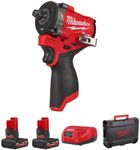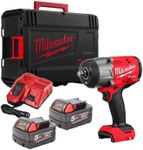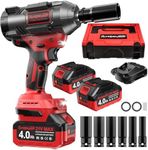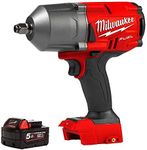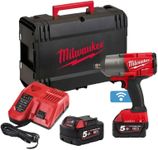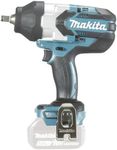Buying Guide for the Best Impact Wrenches
Impact wrenches are powerful tools used to tighten or loosen nuts and bolts with high torque output. They are commonly used in automotive repair, construction, and heavy equipment maintenance. When choosing an impact wrench, it's important to consider the specific tasks you will be performing, as different models offer varying levels of power, speed, and convenience. Understanding the key specifications will help you select the right tool for your needs.TorqueTorque is the rotational force that the impact wrench can apply to a fastener. It is measured in foot-pounds (ft-lbs) or Newton-meters (Nm). Higher torque is important for loosening stubborn or rusted bolts and for heavy-duty applications. Impact wrenches typically range from 100 ft-lbs for light tasks to over 1,000 ft-lbs for industrial use. Choose a torque level based on the toughest job you expect to encounter; for automotive work, around 300-500 ft-lbs is often sufficient.
Drive SizeThe drive size refers to the size of the square drive that holds the socket. Common sizes include 1/4-inch, 3/8-inch, 1/2-inch, 3/4-inch, and 1-inch. Smaller drive sizes are suitable for lighter tasks and tighter spaces, while larger drive sizes are used for heavy-duty applications. For general automotive work, a 1/2-inch drive is typically adequate. Consider the size of the fasteners you will be working with to determine the appropriate drive size.
Speed (RPM)Speed, measured in revolutions per minute (RPM), indicates how fast the impact wrench can rotate. Higher speeds allow for quicker fastening and removal of bolts. However, too much speed without adequate control can lead to over-tightening or damage. Impact wrenches usually offer speeds ranging from 1,000 to 3,000 RPM. If you need precision and control, look for models with variable speed settings.
Impacts Per Minute (IPM)Impacts per minute (IPM) measure how many times the hammer mechanism strikes the anvil per minute. Higher IPM can improve the tool's ability to loosen tough fasteners. Impact wrenches typically range from 2,000 to 4,000 IPM. If you frequently deal with rusted or stuck bolts, a higher IPM can be beneficial. Consider the balance between IPM and torque for your specific needs.
Power SourceImpact wrenches can be powered by electricity (corded or cordless) or air (pneumatic). Cordless models offer portability and convenience, ideal for remote or outdoor work, but require battery management. Corded models provide consistent power without the need for recharging but limit mobility. Pneumatic wrenches are powerful and commonly used in professional settings but require an air compressor. Choose based on your work environment and power availability.
Weight and ErgonomicsThe weight and design of an impact wrench affect user comfort and fatigue during prolonged use. Lighter models are easier to handle and reduce strain, especially in overhead or extended tasks. Ergonomic designs with comfortable grips and balanced weight distribution enhance usability. Consider how long and how often you will use the tool to determine the importance of weight and ergonomics in your decision.

